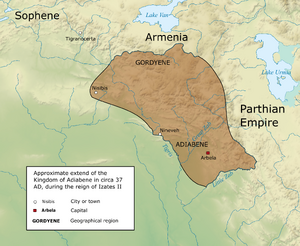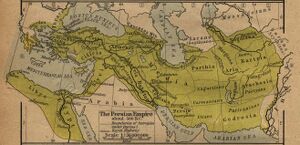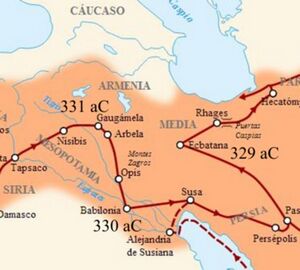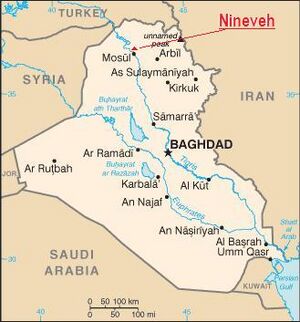Arbela
| Author: Laxman Burdak, IFS (R) |




Arbela or Erbil, locally called Hawler (Kurdish: ھەولێر, Hewlêr; Arabic: أربيل, Arbīl; Syriac: ܐܲܪܒܝܠ, Arbela), also spelled Arbil or Irbil, is the capital and largest city of Kurdistan Region in northern Iraq.
Variants
- Arbela (Anabasis by Arrian, p. 13, 98, 156-171, 334.)
- Arbelitis (Pliny.vi.16, Pliny.vi.31)
Jat Gotras Namesake
Jat Gotras Namesake
- Arbal = Arbela (Anabasis by Arrian, p. 13, 98, 156-171, 334.)
Location
It is located approximately 350 kilometres north of Baghdad.
Etymology
The name Erbil was mentioned in Sumerian holy writings of third millennium BC as Urbilum, Urbelum or Urbillum,[1] which appears to originate from Arbilum[2] Later, the Akkadians and Assyrians by a folk etymology rendered the name as arba'ū ilū to mean (four gods).[3] The city became a centre for the worship of the Assyro-Babylonian goddess Ishtar. In classical times the city became known as Arbela (Ἄρβηλα), from the Syriac language and Assyrian Neo-Aramaic form of the name. In Old Persian the city was called Arbairā.[4]
Today, the modern Kurdish name of the city, Hewlêr, appears to be a corruption of the name Arbel by a series of metatheses of consonants.[5]
History
Human settlement at Erbil can be dated back to possibly 5000 BC, and it is one of the oldest continuously inhabited areas in the world.[6] At the heart of the city is the ancient Citadel of Arbil. The earliest historical reference to the region dates to the Ur III dynasty of Sumer, when king Shulgi mentioned the city of Urbilum. The city was later settled by the Assyrians.[7]
Erbil became an integral part of the kingdom of Assyria by at least the 21st century BC through to the end of the 7th century BC, after it was captured by the Gutians and it was known in Assyrian annals variously as Urbilim, Arbela and Arba-ilu. After this it was part of the geopolitical province of Assyria under several empires in turn, including the Median Empire, the Achaemenid Empire (Achaemenid Assyria), Macedonian Empire, Seleucid Syria, Parthian Empire (Athura), Assyria (Roman province) and Sassanid Empire (Assuristan), as well as being the capital of the Neo-Assyrian state of Adiabene between the mid 2nd century BC and early 2nd century AD. Following the Arab conquest of Persia, Assyria as a geo-political entity (then known as Assuristan/Athura) slowly dissolved, and during medieval times the city came to be ruled by the Seljuk and Ottoman Turks.[8]
Erbil's archaeological museum houses a large collection of pre-Islamic artefacts (particularly Sumerian and Assyrian) and is a centre for archaeological projects in the area.[9] The city was designated as Arab Tourism Capital 2014 by the Arab Council of Tourism.[8][9] In July 2014, Erbil Citadel was inscribed as a World Heritage Site by UNESCO.
Jat History
Bhim Singh Dahiya[10] writes that....The connection of Dahiyas with Persia is further supported by Anabasis who states that the Dahae were one of the Chief tribes of Persia.[11] Their fight at Arbela in 331 B.C., against Alexander, is mentioned by the same authority.[12] It is well known that Cyrus the Great, was killed in battle against the Massagetae, under their Queen Tomyris.
Jats in Battle of Arbela
The various tribes came to the aid of Darius-III (the last king of the Achaemenid Empire of Persia) and were part of alliance in the battle of Gaugamela (331 BC) formed by Darius-III in war against Alexander the Great at Arbela, now known as Arbil, which is the capital of Kurdistan Region in northern Iraq. [13]
Some of Jat tribes associated with Darius-III fighting against Alexander the Great include:
- Bactrians:Takhar Jats who gave the name Tukharistan to the Country
- Sogdianians: Sogaria, Solanki Jats
- Sacians: Saka Jats
- Scythian: Jats
- Arachotians: Arak Jats
- Areians: Aryan Jats
- Parthians: Parad Jat clan, Bhim Singh Dahiya writes that the clan (Gotra) name of some of the seers of the Rigveda are derived from Rishis, which are identifiable with the existing Jat clans, e.g. Tanva Partha (X/193) may represent the present Parad clan, the well-known Parthians of Iran.
- Hyrcanians: Virk Jats
- Medes: Manda Jats
- Cadusians: Kadwa Jats
- Uxians: Ojla, Ujjihana Jats
- Susianians: Suswal Jats
- Babylonians: Babal Jats
- Carians: Kar, Kari, Karia, Kurka Jats
- Armenians: Armenia and Cappadocia were included in the Manda Jat empire.
- Cappadocians:Armenia and Cappadocia were included in the Manda Jat empire.
- Syrians: Asiagh Jats
The Jat tribes fighting against Darius-III and fighting in favour of Alexander the Great include:
- Paeonian : They were Paunia Jats - Herodotus mentions a people, Paeonia, a colony of Teucarians. [14] The paeonians were transferred from Hellespont to Asia, under the orders of Darius the great. Here we have the Pauniya and Tokhar Jats in Europe in sixth century BC.[15]
Ch.8 Description of Darius-III's Army at Arbela against Alexander

They come to the aid of Darius-III (the last king of the Achaemenid Empire of Persia) and were part of alliance in the battle of Gaugamela (331 BC) formed by Darius-III in war against Alexander the Great at Arbela, now known as Arbil, which is the capital of Kurdistan Region in northern Iraq.
Arrian[16] writes....Alexander therefore took the royal squadron of cavalry, and one squadron of the Companions, together with the Paeonian scouts, and marched with all speed; having ordered the rest of his army to follow at leisure. The Persian cavalry, seeing Alexander, advancing quickly, began to flee with all their might. Though he pressed close upon them in pursuit, most of them escaped; but a few, whose horses were fatigued by the flight, were slain, others were taken prisoners, horses and all. From these they ascertained that Darius with a large force was not far off. For the Indians who were conterminous with the Bactrians, as also the Bactrians themselves and the Sogdianians had come to the aid of Darius, all being under the command of Bessus, the viceroy of the land of Bactria. They were accompanied by the Sacians, a Scythian tribe belonging to the Scythians who dwell in Asia.[1] These were not subject to Bessus, but were in alliance with Darius. They were commanded by Mavaces, and were horse-bowmen. Barsaentes, the viceroy of Arachotia, led the Arachotians[2] and the men who were called mountaineer Indians. Satibarzanes, the viceroy of Areia, led the Areians,[3] as did Phrataphernes the Parthians, Hyrcanians, and Tapurians,[4] all of whom were horsemen. Atropates commanded the Medes, with whom were arrayed the Cadusians, Albanians, and Sacesinians.[5] The men who dwelt near the Red Sea[6] were marshalled by Ocondobates, Ariobarzanes, and Otanes. The Uxians and Susianians[7] acknowledged Oxathres son of Aboulites as their leader, and the Babylonians were commanded by Boupares. The Carians who had been deported into central Asia, and the Sitacenians[8] had been placed in the same ranks as the Babylonians. The Armenians were commanded by Orontes and Mithraustes, and the Cappadocians by Ariaoes. The Syrians from the vale between Lebanon and Anti-Lebanon (i.e. Coele-Syria) and the men of Syria which lies between the rivers[9] were led by Mazaeus. The whole army of Darius was said to contain 40,000 cavalry, 1,000,000 infantry, and 200 scythe-bearing chariots.[10] There were only a few elephants, about fifteen in number, belonging to the Indians who live this side of the Indus.[11] With these forces Darius had encamped at Gaugamela, near the river Bumodus, about 600 stades distant from the city of Arbela, in a district everywhere level;[12] for whatever ground thereabouts was unlevel and unfit for the evolutions of cavalry, had long before been levelled by the Persians, and made fit for the easy rolling of chariots and for the galloping of horses. For there were some who persuaded Darius that he had forsooth got the worst of it in the battle fought at Issus, from the narrowness of the battle-field; and this he was easily induced to believe.
1. Cf. Aelian (Varia Historia, xii. 38).
2. Arachosia comprised what is now the south-east part of Afghanistan and the north-east part of Beloochistan.
3. Aria comprised the west and north-west part of Afghanistan and the east part of Khorasan.
4. Parthia is the modern Khorasan. Hyrcania was the country south and south-east of the Caspian Sea. The Tapurians dwelt in the north of Media, on the borders of Parthia between the Caspian passes. Cf. Ammianus, xxiii. 6.
5. The Cadusians lived south-west of the Caspian, the Albanians on the west of the same sea, in the south-east part of Georgia, and the Sacesinians in the north-east of Armenia, on the river Kur.
6. "The Red Sea was the name originally given to the whole expanse of sea to the west of India as far as Africa. The name was subsequently given to the Arabian Gulf exclusively. In Hebrew it is called Yam-Suph (Sea of Sedge, or a seaweed resembling wool). The Egyptians called it the Sea of Weeds.
7. The Uxians occupied the north-west of Persis, and Susiana was the country to the north and west of Persis.
8. The Sitacenians lived in the south of Assyria. ἐτετάχατο. is the Ionic form for τεταγμἑνοι ἦσαν.
9. The Greeks called this country Mesopotamia because it lies between the rivers Euphrates and Tigris. In the Bible it is called Paddan-Aram (the plain of Aram, which is the Hebrew name of Syria). In Gen. xlviii. 7 it is called merely Paddan, the plain. In Hos. xii. 12, it is called the field of Aram, or, as our Bible has it, the country of Syria. Elsewhere in the Bible it is called Aram-naharaim, Aram of the two rivers, which the Greeks translated Mesopotamia. It is called "the Island," by Arabian geographers.
10. Curtius (iv. 35 and 45) states that Darius had 200,000 infantry, 45,000 cavalry, and 200 scythed chariots; Diodorus (xvii. 53) says, 800,000 infantry, 200,000 cavalry, and 200 scythed chariots; Justin (xi. 12) gives 400,000 foot and 100,000 horse; and Plutarch (Alex., 31) speaks of a million of men. For the chariots cf. Xenophon (Anab., i 8, 10); Livy, xxxvii. 41.
11. This is the first instance on record of the employment of elephants in battle.
12. This river is now called Ghasir, a tributary of the Great Zab. The village Gaugamela was in the district of Assyria called Aturia, about 69 miles from the city of Arbela, now called Erbil.
Ch.14 Battle of Arbela.— Plight of Darius
Arrian[17] writes....As soon as Darius began to set his whole phalanx in motion, Alexander ordered Aretes to attack those who were riding completely round his right wing; and up to that time he was himself leading his men in column. But when the Persians had made a break in the front line of their army, in consequence of the cavalry sallying forth to assist those who were surrounding the right wing, Alexander wheeled round towards the gap, and forming a wedge as it were of the Companion cavalry and of the part of the phalanx which was posted here, he led them with a quick charge and loud battle-cry straight towards Darius himself. For a short time there ensued a hand-to-hand fight; but when the Macedonian cavalry, commanded by Alexander himself, pressed on vigorously, thrusting themselves against the Persians and striking their faces with their spears, and when the Macedonian phalanx in dense array and bristling[1] with long pikes had also made an attack upon them, all things at once appeared full of terror to Darius, who had already long been in a state of fear, so that he was the first to turn and flee.[2] The Persians also who were riding round the wing were seized with alarm when Aretes made a vigorous attack upon them. In this quarter indeed the Persians took to speedy flight; and the Macedonians followed up the fugitives and slaughtered them.[3] Simmias and his brigade were not yet able to start with Alexander in pursuit, but causing the phalanx to halt there, he took part in the struggle, because the left wing of the Macedonians was reported to be hard pressed. In this part of the field, their line being broken, some of the Indians and of the Persian cavalry burst through the gap towards the baggage of the Macedonians; and there the action became desperate. For the Persians fell boldly on the men, who were most of them unarmed, and never expected that any men would cut through the double phalanx and break through upon them.[4] When the Persians made this attack, the foreign prisoners also assisted them by falling upon the Macedonians in the midst of the action. But the commanders of the men who had been posted as a reserve to the first phalanx, learning what was taking place, quickly moved from the position which they had been ordered to take, and coming upon the Persians in the rear, killed many of them there collected round the baggage. But the rest of them gave way and fled. The Persians on the right wing, who had not yet become aware of the flight of Darius, rode round Alexander's left wing and attacked Parmenio in flank.[5]
1. πεφρικυῖα, imitated from Homer (Iliad, iv. 282). Cf. Vergil (Aeneid, x. 178, horrentibus hastis); Livy, xliv. 41 (horrendis hastis).
2. Curtius (iv. 58, 59) and Diodorus (xvii. 60) describe quite an Homeric battle, Darius hurling a spear at Alexander, and Alexander hurling his at Darius and killing his charioteer. They say that the Persians mistook the fall of the charioteer for that of the king, and fled, carrying Darius with them.
3. Curtius (iv. 59) and Diodorus (xvii. 60) say that so thick a cloud of dust was raised by the mighty mass of fugitives, that nothing could be clearly distinguished, and that thus the Macedonians lost the track of Darius. The noise of the shouting and the cracking of whips served as guides to the pursuers.
4. Sisygambis, the mother of Darius, whom these Persians were especially anxious to liberate from the custody of the Macedonians, refused to go with them. See Diodorus and Curtius.
5. Arrian does not say much about this vigorous charge of Mazaeus, the commander of the Persian right wing. See Curtius (iv. 60); Diodorus (xvii. 60).
Population
The city has an ethnically diverse population of Kurds, Assyrians, Arabs, Armenians, Iraqi Turkmens, Yezidis, Shabakis and Mandeans. It is equally religiously diverse, with believers of Sunni Islam, Shia Islam, Christianity (mainly followed by Assyrians and Armenians), Yezidism, Yarsan, Shabakism and Mandeanism extant in and around Erbil.
Mention by Pliny
Pliny[18] mentions Adiabene.... The kingdom of the Persians, by which we now understand that of Parthia, is elevated upon the Caucasian chain between two seas, the Persian and the Hyrcanian. To the Greater Armenia, which in the front slopes towards Commagene, is joined Sophene, which lies upon the descent1 on both sides thereof, and next to it is Adiabene, the most advanced frontier of Assyria; a part of which is Arbelitis,2 He alludes to the town of Arbela, where, as it is generally said, the army of Darius was defeated by Alexander the Great; by which engagement the conflict was terminated. It was the fact, however, that Darius left his baggage and treasures at Arbela, while the battle really took place near the village of Gaugamela, about twenty miles to the north-west of Arbela. This place still retains its name of Arbil, where Alexander conquered Darius, and which joins up to Syria. The whole of this country was called Mygdonia by the Macedonians, on account of the resemblance it bore to Mygdonia3 in Europe. Its cities are Alexandria,4 and Antiochia, also called Nisibis5; this last place is distant from Artaxata seven hundred and fifty miles. There was also in former times Ninus6, a most renowned city, on the banks of the Tigris, with an aspect towards the west. Adjoining the other front of Greater Armenia, which runs down towards the Caspian Sea, we find Atropatene7, which is separated from Otene, a region of Armenia, by the river Araxes; Gazæ8 is its chief city, distant from Artaxata four hundred and fifty miles, and the same from Ecbatana in Media, to which country Atropatene belongs.
1 35 See c. 10.
2 He alludes to the town of Arbela, where, as it is generally said, the army of Darius was defeated by Alexander the Great; by which engagement the conflict was terminated. It was the fact, however, that Darius left his baggage and treasures at Arbela, while the battle really took place near the village of Gaugamela, about twenty miles to the north-west of Arbela. This place still retains its name of Arbil.
3 A district in the east of Macedonia, bordering on the Thermaic gulf and the Chalcidic peninsula.
4 Nothing is known of this place. Hardouin suggests that it may have been built on the spot where Alexander defeated Darius.
5 Also known as Antiochia Mygdoniæ, the capital of Mygdonia. Its ruins are still to be seen near a place called Nisibin. It stood on the river Mygdonius, now the Nahral Huali.
6 Or Nineveh, the capital of the great Assyrian monarchy, destroyed by the Medes and Babylonians about B.C. 606.
7 There is great difficulty in ascertaining, from the accounts given by the ancient writers, the exact limits of this district, but it is supposed to have included a considerable portion of the province now known by the name of Azerbaijan. It derived its name from Atropates or Atropes, who was governor of this district under the last Darius.
8 Most probably the place now known as Gazæa, the royal residence of the Parthian kings, and, as its name would imply, their treasure city. Colonel Rawlinson thinks that this place underwent many changes of name according to the rulers who successively occupied it; among other names, it appears to have borne that of Ecbatana.
Mention by Pliny
Pliny[19] mentions....Between these peoples and Mesene is Sittacene, which is also called Arbelitis24 and Palæstine. Its city of Sittace25 is of Greek origin; this and Sabdata26 lie to the east, and on the west is Antiochia27, between the two rivers Tigris and Tornadotus28, as also Apamea29, to which Antiochus30 gave this name, being that of his mother. The Tigris surrounds this city, which is also traversed by the waters of the Archoüs.
24 From Arbela, in Assyria, which bordered on it.
25 A great and populous city of Babylonia, near the Tigris, but not on it, and eight parasangs within the Median wall. The site is that probably now called Eski Baghdad, and marked by a ruin called the Tower of Nimrod. Parisot cautions against confounding it with a place of a similar name, mentioned by Pliny in B. xii. c. 17, a mistake into which, he says, Hardouin has fallen.
26 Now called Felongia, according to Parisot. Hardouin considers it the same as the Sambana of Diodorus Siculus, which Parisot looks upon as the same as Ambar, to the north of Felongia.
27 Of this Antiochia nothing appears to be known. By some it has been supposed to be the same with Apollonia, the chief town of the district of Apolloniatis, to the south of the district of Arbela.
28 Also called the Physcus, the modern Ordoneh, an eastern tributary of the Tigris in Lower Assyria. The town of Opis stood at its junction with the Tigris.
29 D'Anville supposes that this Apamea was at the point where the Dijeil, now dry, branched off from the Tigris, which bifurcation he places near Samurrah. Lynch, however, has shown that the Dijeil branched off near Jibbarah, a little north of 34° North lat., and thinks that the Dijeil once swept the end of the Median wall, and flowed between it and Jebbarah. Possibly this is the Apamea mentioned by Pliny in c. 27.
30 The son of Seleucus Nicator.
External links
References
- ↑ Hamblin, William J. (2006). Warfare in the Ancient Near East to 1600 BC. Routledge. p. 111. ISBN 0-415-25589-9.
- ↑ Khan, Geoffrey (1999). A grammar of neo-Aramaic: the dialect of the Jews of Arbel, Part 1, Volume 47. BRILL. p. 2. ISBN 978-90-04-11510-1.
- ↑ Khan, Geoffrey (1999). A grammar of neo-Aramaic: the dialect of the Jews of Arbel, Part 1, Volume 47. BRILL. p. 2. ISBN 978-90-04-11510-1.
- ↑ "Iranica: Arbela". Iranicaonline.org
- ↑ Khan, Geoffrey (1999). A grammar of neo-Aramaic: the dialect of the Jews of Arbel, Part 1, Volume 47. BRILL. p. 2. ISBN 978-90-04-11510-1.
- ↑ Novácek, Karel (2008). "Research of the Arbil Citadel, Iraq, First Season". Památky Archeologické (XCIX): 259–302
- ↑ Hamblin, William J. (2006). Warfare in the Ancient Near East to 1600 BC. Routledge. p. 111. ISBN 0-415-25589-9.
- ↑ Georges Roux – Ancient Iraq
- ↑ Georges Roux – Ancient Iraq
- ↑ Bhim Singh Dahiya: Jats the Ancient Rulers (A clan study)/The Antiquity of the Jats,p.252
- ↑ Chapter XIII.
- ↑ Chapter III/2.
- ↑ Arrian:The Anabasis of Alexander/3a, Ch.8
- ↑ v, 12-27
- ↑ Bhim Singh Dahiya: Jats the Ancient Rulers (A clan study)/Jat Clan in India, p. 267-268
- ↑ The Anabasis of Alexander/3a, Ch.8
- ↑ The Anabasis of Alexander/3a, Ch.14
- ↑ Natural History by Pliny Book VI/Chapter 16
- ↑ Natural History by Pliny Book VI/Chapter 31
Back to Jat Places in Iraq

